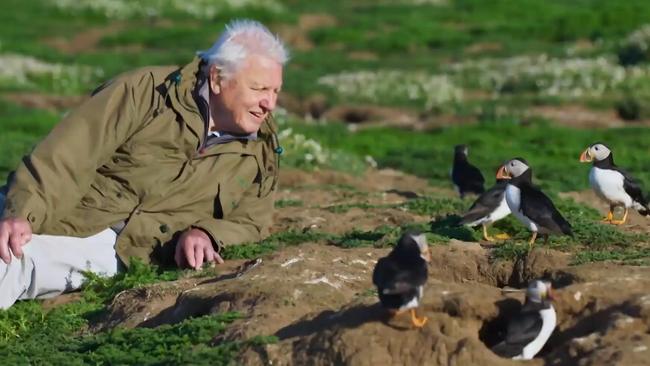Blighty gets the full bells-and-whistles Planet Earth treatment
David Attenborough is right: nature in the United Kingdom can be just as dramatic as anywhere else.

Good. It’s about time that Blighty got the full bells-and-whistles Planet Earth treatment. Let’s not take for granted what’s right under England’s noses and always look to the exotic to be wowed. Because Wild Isles was spectacular, even if the wonders were more familiar, and owls and dormice will never quite be as sexy as iguanas versus racer snakes. We’ve got damselflies, the male of which collects his sperm from an opening near his head; thank the Lord this isn’t the case with humans.
The BBC has denied claims that a sixth episode of the series made with the WWF and the RSPB will only be broadcast on iPlayer over fears of a backlash from Tory MPs and the right-wing press. Who knows what’s going on over there at the moment.
I’m just glad there wasn’t a strong gust of wind when David Attenborough, aged 96, stood on that high cliff edge for the opening shots in his North Face coat. It doesn’t bear thinking about.
Attenborough, referring immediately to his “long life” – a phrase that made me wistful, for who knows how much longer we’ll have him – was right. Nature here at home can be just as dramatic as anywhere else.
We owe much of the diversity of our wildlife to the UK’s great range in temperature. In the south we get palm trees and subtropical conditions, and in the Cairngorms it can drop to minus 27C. In a relatively small country too.
The scenes with the orcas were breathtaking and, as is usually the way with these programs, distressing. To me anyway. We were barely six minutes in before the killing started, that poor seal pup being tossed around and set upon by a pod of killer whales. But the sequence flagged up something else we perhaps take for granted (I do, at least). It took two years to secure that footage. What we don’t see as we put our feet up with a cup of tea is the hundreds of hours lost and the colossal amount of patience with which the camera crew must be blessed. And then in a few minutes it was over and we’d moved on to golden eagles, dormice and badgers. Oh, and more killing.
I was enjoying the scenes with the barnacle geese, 30,000 of which migrate here from Greenland, Attenborough’s chocolatey voiceover told us. Until, that is, the white-tailed eagles came like armed gangsters who enter a pub and clear it.
The amazing scene in which the hardcase eagle was stamping on the goose’s head, trying to drown it, was horrific and mesmerising. That eagle was like a Quentin Tarantino thug. What a bummer. You fly 2,000 miles to become a bigger bird’s supper.
Thankfully the puffins’ travails were less horror-flick, although not if you’re a sand eel. They could cram about seven in their beaks at a time, only to have those black-headed gulls try to steal them literally from their mouths. Lazy sods. Get your own, mate.
Attenborough, who lay on the ground next to the puffins looking much younger than his years (I know people far more youthful who wouldn’t have fancied that hike), has never made a big series about the British Isles before.
You can’t help but wonder, given his age, if this will be his last full series, and I wish we’d seen a bit more of him. Sources say that more are in the pipeline. I do hope so.
Perhaps because it featured domestic wildlife some viewers won’t be as blown away as they were with, say, jaw-dropping scenes from the Galapagos. But, as with all these films, the effort that has gone into it is first-class.
Wild Isles is streaming on Prime Video

To join the conversation, please log in. Don't have an account? Register
Join the conversation, you are commenting as Logout